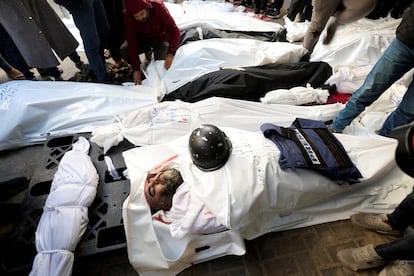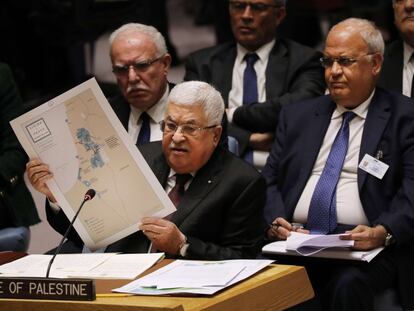Surviving to report: Gaza journalists, both victims and witnesses of the war
According to the Committee to Protect Journalists, 68 reporters have been killed during the Israeli offensive. ‘We are not machines. We have feelings,’ says one of the Palestinian journalists who spoke to EL PAÍS

“An attack that doesn’t kill you makes you stronger and stronger and stronger.” Palestinian journalist Mohamed Balousha wrote this message after being shot in his left leg on December 15, while recording Israeli troop positions in Gaza City. It’s unknown how he is recovering. The day before, Balousha relayed via to EL PAÍS via voice messages the attacks that were taking place in the Sheik Radwan neighborhood. He is one of the few reporters who, risking their lives on a daily basis, remains in the north of Gaza. His exclusive reports, broadcast by the Emirati television network Al Mashhad, are one of the most widely watched of the war.
In an uncensored video from November 27, which EL PAÍS has seen without pixelated images, he puts a face to the ignominy of the conflict. The video shows at least four babies, abandoned in the ICU of the Al Nasr hospital, in a state of putrefaction. They have been eaten by worms and flies, and are still attached to cables and respirators. Two and a half weeks earlier, the hospital was besieged, attacked and evacuated by order of the Israeli army. If the world can see tragedies like this and the others that are taking place daily in Gaza, it is thanks to him and the other journalists who are reporting the war from the ground for Palestinian and international media.
EL PAÍS contacted some of these unique witnesses of a war, in which the main battlefield — Gaza, where more than 20,000 people have died — is being blocked by Israel. Mohamed Balousha is still alive in Gaza for the moment, but 68 reporters and media workers (61 Palestinians, four Israelis and three Lebanese) have been killed since October 7, and another three are missing, according to the Committee to Protect of Journalists (CPJ). In 10 weeks of war, more journalists were killed in Gaza than in any other country in the whole year, CPJ reported last Thursday.
Mahmud, 30, tries to dispel the idea that reporters in Gaza are emotionally immune to what is happening around them. “We are being treated as if we were less than human. I have every right to feel pain. I have every right to mourn my murdered family members. I have every right to feel afraid,” says the reporter. Mahmud works for a large international media outlet and is not authorized to make statements: he only agrees to speak on the condition that neither the company he works for nor his real name be published.
Like the other journalists who spoke to EL PAÍS, Mahmud has to deal with the daily struggle of finding food and water, he says from the three-story home he shares with about 70 people in Rafah, at the southern end of the Gaza Strip, where he has been staying since escaping Gaza City. Unlike other journalists, he has his own solar panel system, provided by his company, and that makes his work easier, although his batteries are lasting for shorter and shorter periods of time.
Priority: survival
Amid the uncontrolled violence, the reporters covering the conflict in Gaza — an open-air cage with 2.3 million inhabitants — must prioritize survival over reporting.
Almost all the journalists who spoke to EL PAÍS escaped from the north of Gaza to the middle and southern areas of the Palestinian enclave, where they are sheltering in overcrowded conditions with relatives or acquaintances. In the midst of the brutal humanitarian crisis that is gripping Gaza, reporters must find food, water and shelter, as well as transportation, power to charge the batteries of their electronic devices, and internet connection to send their work to their publishers.
As seen in other modern wars, social media is playing a key role: it has thrown some Palestinian reporters into the limelight and helped share their work. For example, photographer Motaz Azaiza, who is reporting on the conflict from southern Gaza, has more than 17 million followers on Instagram. Hamas and other Palestinian armed groups share their own propaganda videos, but do not give reporters access to their operations or the places where they are holding hostages.
“I have covered the displacement of people from the north to the south and also between cities in the south. I myself was one of them. Sometimes, I had to walk or ride a donkey-pulled cart pulled to get to the places to cover the stories,” explains Sami Alajrami, 55, who has been working for the Italian agency Ansa as a correspondent for 12 years. He has already moved seven times since he left his home in the north to settle first in Deir al Balah, in the center of the country, and now in Rafah. At the beginning of the war, Alajrami says in a written message, he paid 10 times the normal price for fuel so he could move around and do his job. “I have covered the murder of 14 members of my family who were also displaced,” he says, giving an idea of how difficult it is to separate the journalist from the victim, as nearly all reporters fall into this category.
With most of the reporters displaced along with 1.8 million inhabitants, the most difficult situation is in the north of Gaza, where only a handful remain on the ground. The north of Gaza has been the hardest hit by the Israeli army, which continues to strike the area. Hardly any residents are left. There, journalists — now seasoned in current conflict given that replacements or colleagues cannot access Gaza — try to move in groups in the midst of constant fighting and bombings such as the one that wounded Islam Bader in the neck on Tuesday. The freelance reporter, who works for the Qatari network Al Araby, was in the Jabalia refugee camp when a bombing killed dozens of people.
In a two-story house in the Al-Maghazi refugee camp, in the center of Gaza, another freelance reporter, Aseel Musa, 26, has taken refuge with 50 other people. It has a generator, but no fuel to power it. This means there is no electricity in the house, so she uses a neighbor’s solar panels to charge her computer and phone, her main work tools. With no fuel for cars either, she has to move on foot. “We depend on firewood to heat water and cook. What we have is only canned food, pasta or rice,” Musa explains in responses sent through voice notes.
“Journalists in Gaza are not protected, and we are working in an extremely difficult situation,” laments Akram al Satarri, a 47-year-old reporter, who says he has not witnessed such a degree of violence despite covering all the wars in Gaza since 2005, when Israel left the enclave. Like Alajrami and Musa, this freelance journalist also fled from Gaza City to the south with his family. “I don’t think there is a safe haven in all of Gaza,” he says from Khan Younis in a phone call and voice messages.
Six hours with two bullets
“Two bullets hit me in the leg and I fell to the ground. After six hours, I crawled to the second floor, where I had a first aid kit, with which I stopped the bleeding. […] A friend came to see me with four others, and they transported me on a wooden board for two or three kilometers to the nearest medical point,” says Mohamed Balousha in a message.
Journalists in the Palestinian enclave “have paid, and continue to pay, an unprecedented toll and face exponential threats. Many have lost colleagues, families, and media facilities, and have fled seeking safety when there is no safe haven or exit,” Sherif Mansour, CPJ coordinator in the region, says in an alert.
As well as risking their lives, reporters also face threats, arrests, censorship and the loss of their own family members. “The main problem of being a journalist in Gaza is that I don’t feel safe. Israel attacks journalists and their families,” adds Aseel Musa, who has lost six family members in the conflict, adding that he is also threatened and insulted on social media.
Mahmud — who has lost a large number of family members, acquaintances and colleagues in these weeks — says he receives threats from “Israeli settlers who want to kill me, rape my wife or murder my son with the intention of stopping my work or intimidating me.”
One of the most recent journalists to be killed was Samer Abudaqa, an Al Jazeera cameraman, who was hit by the projectile launched from an Israeli drone. It took hours for him to be rescued due to the intense bombing, and he did not survive the attack, according to Al Jazeera and his colleague, Wael al Dahdouh, who was wounded in that same bombing. Al Dahdouh lost his wife, a son, a daughter and a grandson in another Israeli attack in October, but within hours he was back in front of the camera.
“It is very important to understand that we are also victims of this conflict and that we can and are being killed,” says Mahmud. But, despite the determination and strength of colleagues like Al Dahdouh, he insists: “We are not machines. I mean, we have feelings, and we need to cry sometimes, but we are almost always treated like machines. And, in any case, we have to end up doing the job.”
Sign up for our weekly newsletter to get more English-language news coverage from EL PAÍS USA Edition
Tu suscripción se está usando en otro dispositivo
¿Quieres añadir otro usuario a tu suscripción?
Si continúas leyendo en este dispositivo, no se podrá leer en el otro.
FlechaTu suscripción se está usando en otro dispositivo y solo puedes acceder a EL PAÍS desde un dispositivo a la vez.
Si quieres compartir tu cuenta, cambia tu suscripción a la modalidad Premium, así podrás añadir otro usuario. Cada uno accederá con su propia cuenta de email, lo que os permitirá personalizar vuestra experiencia en EL PAÍS.
¿Tienes una suscripción de empresa? Accede aquí para contratar más cuentas.
En el caso de no saber quién está usando tu cuenta, te recomendamos cambiar tu contraseña aquí.
Si decides continuar compartiendo tu cuenta, este mensaje se mostrará en tu dispositivo y en el de la otra persona que está usando tu cuenta de forma indefinida, afectando a tu experiencia de lectura. Puedes consultar aquí los términos y condiciones de la suscripción digital.
More information
Archived In
Últimas noticias
Most viewed
- Sinaloa Cartel war is taking its toll on Los Chapitos
- Oona Chaplin: ‘I told James Cameron that I was living in a treehouse and starting a permaculture project with a friend’
- Reinhard Genzel, Nobel laureate in physics: ‘One-minute videos will never give you the truth’
- Why the price of coffee has skyrocketed: from Brazilian plantations to specialty coffee houses
- Silver prices are going crazy: This is what’s fueling the rally










































